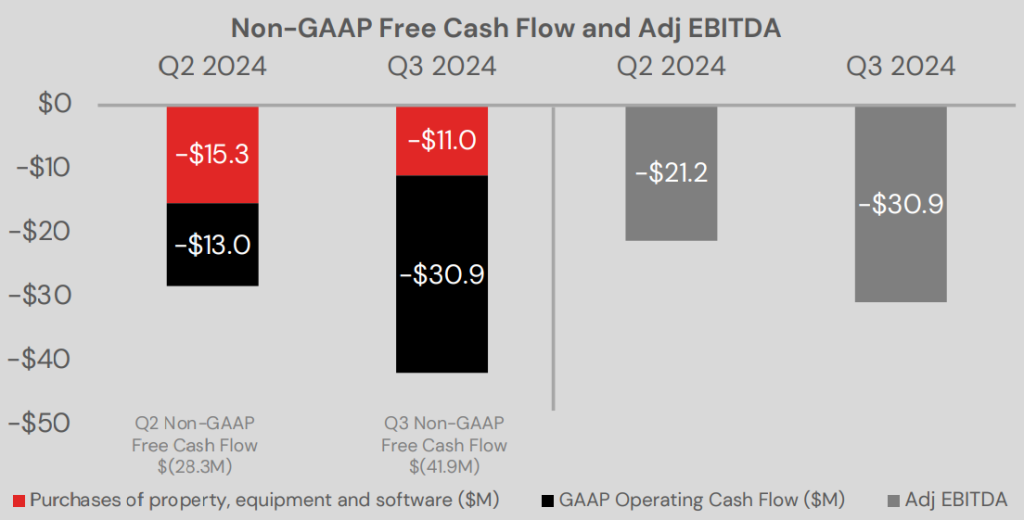e.l.f. Beauty stock plummets 20% as revenue and guidance fall short of expectations
At the end of the month, on February 27th, Intuitive Machines Inc (NASDAQ:LUNR) is scheduled to launch its second Commercial Lunar Payload Services (CLPS) mission to the Moon, this time delivering NASA’s PRIME-1 drill.
Since last February, when Intuitive Machines landed Nova-C after a 50-year lunar hiatus, LUNR stock is up 267%. In the same period, Rocket Lab USA, Inc. (NASDAQ:RKLB) is up 501%.
Can investors expect to see similar gains throughout 2025, and should they favor one space company over the other?
Discrepancy in LUNR vs RKLB Valuations Explained
Although the beneficiary of NASA’s $4.82 billion Near Space Network (NSN) contract, Intuitive Machines has a spaced out milestone schedule. After this February’s IM-2 mission, the next IM-3 is planned for either late 2025 or early 2026.
This chronological distance between missions translates into fewer public spotlights for investor attention. And with fewer missions, there are fewer opportunities to showcase progress interesting to investors. They already know that Intuitive Machines’ funding is reliant on government contracts (NASA) and that the company is unlikely to lose them due to high human capital scarcity in this sector.
Moreover, Intuitive Machines operates in the niche segment of lunar landers and exploration. Nonetheless, LUNR stock went up so rapidly because it is the only lunar stock worth holding.
In contrast, Rocket Lab USA has many operational milestones, as a space company developing reusable rockets for the small satellite launch market. This market lends itself inherently to a sustainable profitability path because there is persistent demand for satellites in a global digital economy.
And with each successful rocket launch, Rocket Lab proves it can scale and meet that high demand. This is why Rocket Lab’s market cap rose to $14 billion after the most recent 59th Electron mission for the French Internet-of-Things (IoT) company Kinéis.
On top of its demonstrated competence, Rocket Lab also benefits greatly from SpaceX remaining unlisted. Despite being dominant with medium-sized rockets Falcon 9, Starship and Starlink, the absence of the SpaceX IPO makes investors look at RKLB as the closest pure-play space stock proxy.
Opportunities for Investors: LUNR or RKLB?
With a lower mission frequency cadence, investors can look into long periods of inactivity for LUNR exposure when the stock price goes down. However, as Intuitive Machines helps to set up the infrastructure for 4k resolution video data, Moon mapping and logistics, this would be a major cultural milestone. In turn, Intuitive Machines could be seen as the foundational layer for the emerging lunar economy.
With the current Trump admin, it may even be the case that the recently exposed massive fraudulent government spending could open a pathway for more space funding. NASA’s fiscal budget for 2024 was $24.87 billion, in shadow of USAID’s controversial budget of $71.9 billion in fiscal 2023.
And that is USAID alone, which appears to have served as a patronage network for global ideological activism. Eliminating such expenditures would go a long way to boost relatively cheap Artemis-like programs from NASA, which would benefit Intuitive Machines.
However, the case for Rocket Lab is even more bullish, as the company ranked 3rd globally in rocket launches for 2024. Intuitive Machines has so far relied on SpaceX for its Falcon 9 rockets to deliver landers. This could change with upcoming medium-sized, reusable Neutron rockets from Rocket Lab, comparable to Falcon 9 in payload capacity.
Neutron Changes the Space Game for Rocket Lab
Powered by 9 Archimedes engines and having 13,000 kg payload to low Earth orbit (LEO), Neutron rockets should debut in the second half of 2025, with commercial launches starting in 2026. At this point, if Rocket Lab’s Electron success transfers to Neutron, the company will become a true SpaceX rival and be valued accordingly.
In November’s investor update for Q3, Rocket Lab’s end-to-end business model, from launch and spacecraft to space services, showed significant progress. The company reported an 80% year-over-year backlog growth to $1.05 billion, having increased the quarter’s revenue by 55% to $105 million.
Although the profitability is not there yet, Rocket Lab has plenty of cash for the current rate of expenditures expressed by free cash flow.

So far in 2025, RKLB stock is up 16.5% while LUNR stock flatlined a 0.5% gain. This reinforces the thesis that Rocket Lab is a more rewarding and agile space stock exposure with an optimistic horizon.
Price Targets for LUNR and RKLB
At the moment, it appears that LUNR’s price level of $19.35 is aligned with its average price target of $18, per WSJ forecasting data. However, investors should not be surprised if they see significant price moves up just before and after the IM-2 mission at the end of February.
Against the RKLB’s current price of $28.35, its median price target is $25.50 per share. In both cases, the scarcity of space stocks appears to have given a boost to LUNR and RKLB valuations beyond expected.
Nonetheless, at a first sign of a stock market correction, investors should consider Rocket Lab USA (RKLB) as the primary space stock exposure, one that is likely to even aid lunar exploration if all goes well with Neutron rockets.
***
Neither the author, Tim Fries, nor this website, The Tokenist, provide financial advice. Please consult our website policy prior to making financial decisions.
